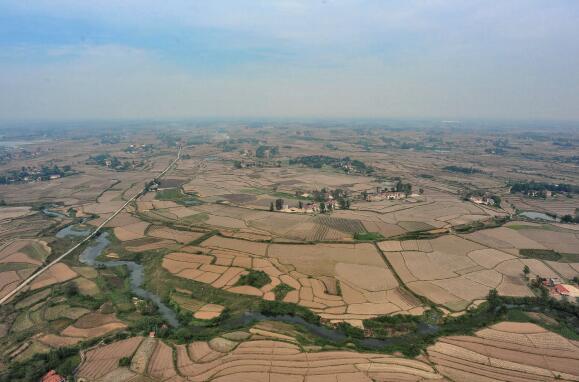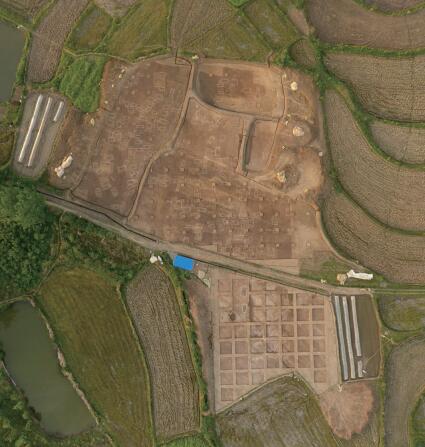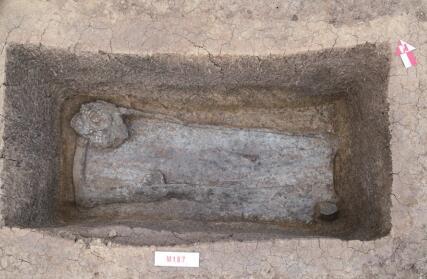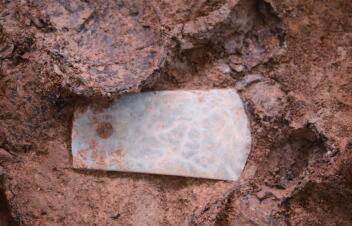Large Cemetery of Qujialing Culture Discovered at Chenghe Site, Hubei Province
Chenghe Site is located in Hougang Town, Shayang County, Jingmen City, Hubei Province, on the west bank of the Hanjiang River and the north bank of Changhu Lake. This site is surrounded by Chenghe River and its tributaries through the west, south and east side and they converge at the southeast. In November 2012, the first excavation was conducted by a joint archaeological team, including the Institute of Archaeology, Chinese Academy of Social Sciences, Hubei Provincial Institute of Cultural Relics and Archaeology, Jingmen Municipal Museum and the Heritage Administrative Office of Shayang County. This excavation aimed to research on the settlement features and social structure of Qujialing Culture. By December 2017, it has carried out five excavation and systematic prospecting, and revealed residential areas, pottery workshops, central square facilities, large courtyard buildings with ancillary facilities, and even some special features related to ritual activities. These accomplishments indicate that this site is an important walled-enclosure settlement of Qujialing-Shijiahe culture, covering an area of about 700,000 square meters. Moreover, we are able to reach a comprehensive understanding of the surrounding settlement patterns through regional systematic survey.

In November 2017, the joint archaeological team conducted prospecting at Wangjiabang locality, about 200 meters far away outside the north wall and found 235 tombs of Qujialing culture. Therefore systematic excavation began in March 2018 and they have cleaned up 112 tombs so far along with great achievements. Generally speaking, these tombs have following characteristics.

First, the structure of the tomb pits and coffins is clear and distinctive. Most tombs are earthen shaft pit tombs, but few of them have slightly "side cave" and half of the coffin is embedded in the side cave. More than 70% of the tombs have funeral furniture, and the proportion and integrity of preservation is very rare in prehistoric cemeteries in the middle reaches of the Yangtze River. The traces of funeral furniture include the rectangular frame of wooden coffins, as well as tree-trunk coffins, some of which are up to 1.5 meters in diameter. This is the first time to discover abundant prehistoric trunk coffins in the middle reaches of the Yangtze River. In addition, it also recovers multi-chambers in one tomb pit. Most of the burial styles are extended supine position, and a few are flexed and secondary burial.

Secondly, the cemetery unearths abundant funeral goods. Almost all tombs are accompanied by potteries. Some tombs have only several potteries, while large scale tombs own more than 60 potteries. Polished black clay pottery account for a large proportion, and it contains thin-necked pots, dou vessel, pots, pot-shaped ding tripod, bottle-shaped ding tripod, straight-wall cups with ring foot, yu-shaped pot, lid, basin (pen), urn (weng), cylinder pot (gang), etc. Some of the combinations are revealed for the first time. Along with potteries, there are also jade axe yue, stone axe yue, cane-ware, pig mandible, lacquer ware and suspected wooden objects.

Thirdly, it shows hierarchical differentiation considering the scale of burials, burial furniture and funeral goods. In the excavation area, there are 7 large scale tombs with an area of more than 10 square meters. Large and medium scale tombs have gigantic coffins, elegant jade axe-yue, stone-axe yue, lacquer ware, and plenty of polished black pottery, pig mandible and other relics. In the filling earth of those graves, urns and red sandy pottery cylinders are recovered. While the small scale tombs are small and few of them has burial furniture only with less potteries. Several small tombs even shared one burial goods pit.
M202 and M112 is 17.3 and 22.4 square meters respectively, which are larger than most graves found in China in the contemporary prehistorical culture. M202 has two chambers in the same pit. It is a rectangular earthen shaft pit tomb, 4.38 meters long, 3.95 meters wide, and 2.5 meters deep. There are second-tiered platforms with raw soil at east and north sides. The tomb wall is regularized and some tool traces are preserved. There are two parallel north-south chambers at the bottom, separated by a 0.5 meters wide and 0.8 meters high balk. Trunk coffins with vertical wall and arc bottom are found in both chambers. More than 60 polished black potteries are buried inside and outside the coffins. Lacquer plates and cane-ware are also unearthed outside the coffins. Grave filling is accompanied by several large containers with lids, such as urns, pots and cylinders. M155 also has two north-south chambers, 4.38 meters long and 3.2 meters wide, with a balk dividing them. The trunk coffin is well preserved. Lacquer ware and a large number of polished black potteries are placed inside and outside the coffin. Jade axe-yue and traces of red lacquer handle are revealed near the right femur of the tomb owner. The jade yue axe is 25 centimeters long, and the blade is 13 centimeters wide while the handle traces are 60 centimeters long.

M112 is located at the center of the cemetery with three chambers. It is 5.95 meters long from east to west and 4.1 meters wide from north to south and 1.25 meters deep. It is also separated by balk. All the chambers are rectangular earthen shaft pit. The middle chamber is larger, 2.9 meters long and 1.6 meters wide and other two chambers are obviously smaller, with a treetrunk coffin buried in each tomb. The coffin in the middle tomb is much larger, 1.5 meters in diameter. Inside the coffin, stone yue, ivory piers, lacquer ware and a large number of polished black potteries are unearthed. While Outside the coffin, it reveals a large vermilion lacquer plate. However, only few potteries are found inside the coffins of the other two chambers. Considering plenty of lid containers are concentrated on the top of the middle tomb, it indicates that the identity of the owner of the middle chamber is higher than the other two chambers.

Those mentioned large scale tombs are located at central, southwest, northwest and northeast areas of the cemetery, and they are surrounded by several medium-scale, sub-medium-scale and small-scale tombs, showing an unequivocal layout.

So far, we have unearthed significant remains such as walls, artificial water system, large buildings and sacrificial features, hence to reveal the development of Qujialing society from the perspective of internal settlement feature. Wangjiabang Cemetery is the largest and the most complete cemetery of Qujialing culture till now. It fills in the gaps of the discovery of the large scale prehistoric tombs in the middle reaches of the Yangtze River and provides crucial information for exploring the social structure of Qujialing culture. Systematic excavation of the trinity of walls, residence and cemetery enriches research data on civilization process in the middle reaches of the Yangtze River. The well preserved coffins, rich funeral objects, and social ranks clearly suggest that Qujialing society has formed a complete and unique funeral ritual, and reached the same level compared with prehistoric societies in Haidai area (Shandong area) and the lower reaches of the Yangtze River in the same period. (Translator: Sun Dan)

